AUEC2-001: Advanced Manufacturing & Engineering Safety Assignment
VerifiedAdded on 2022/09/26
|32
|7826
|59
Homework Assignment
AI Summary
This document provides a comprehensive overview of safety regulations and procedures relevant to the Advanced Manufacturing and Engineering Technician (Foundation Competence) AUEC2-001 module. It covers key aspects of the Health and Safety at Work Act 1974, including employer and employee duties, sources of safety information, and warning signs for dangerous substances. The assignment delves into hazard control measures, risk assessment methodologies, and control measures to minimize risks. It also addresses accident and emergency procedures, including the Reporting of Injuries, Diseases and Dangerous Occurrences Regulations (RIDDOR) and fire safety protocols. Furthermore, the document details the importance of appropriate personal protective equipment (PPE), proper behavior in the working environment, manual handling techniques, housekeeping practices, and the safe storage and disposal of tools, equipment, and materials within a workshop setting. The document emphasizes the significance of adhering to organizational safety policies and procedures to ensure a safe working environment.
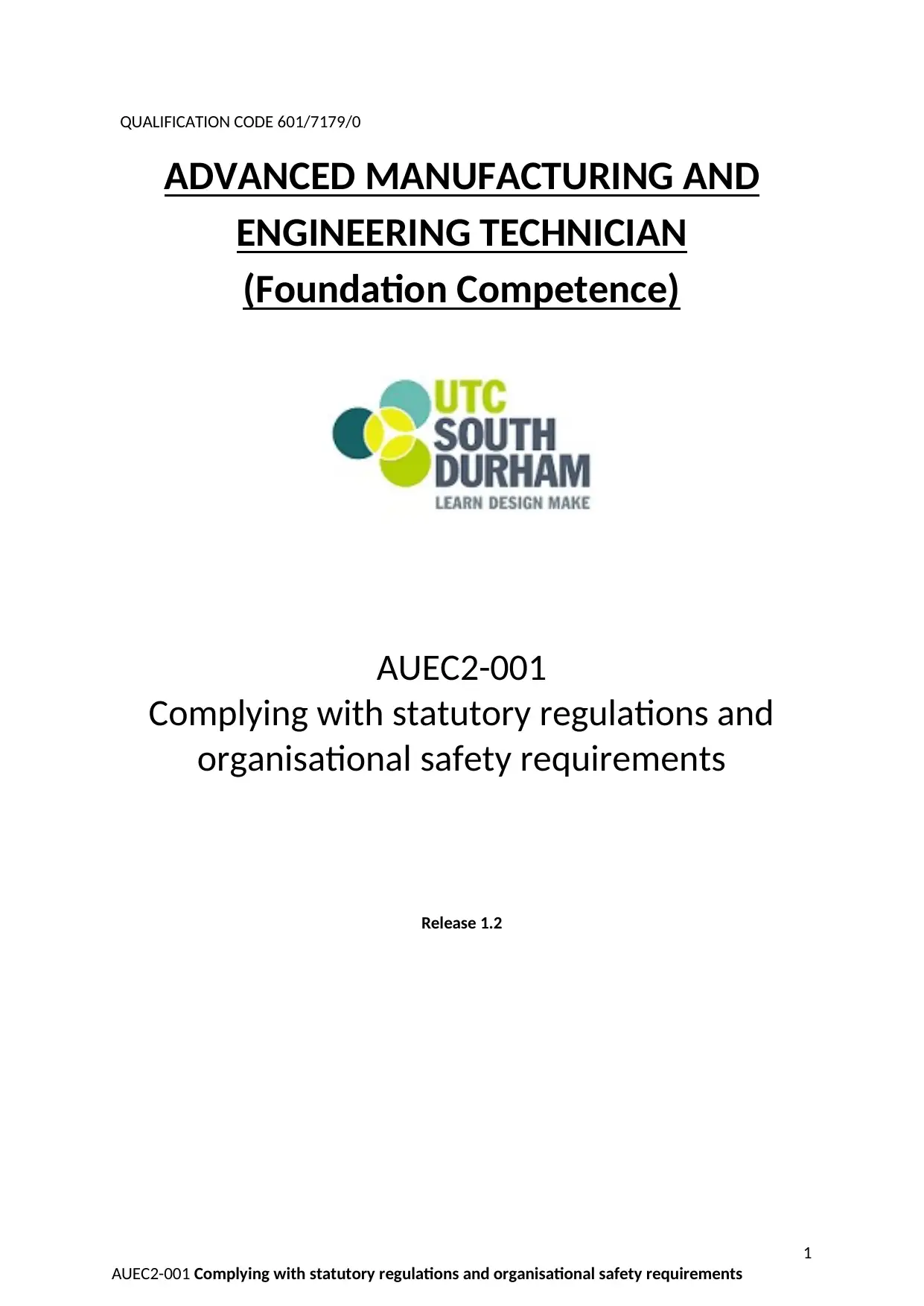
1
AUEC2-001 Complying with statutory regulations and organisational safety requirements
QUALIFICATION CODE 601/7179/0
ADVANCED MANUFACTURING AND
ENGINEERING TECHNICIAN
(Foundation Competence)
AUEC2-001
Complying with statutory regulations and
organisational safety requirements
Release 1.2
AUEC2-001 Complying with statutory regulations and organisational safety requirements
QUALIFICATION CODE 601/7179/0
ADVANCED MANUFACTURING AND
ENGINEERING TECHNICIAN
(Foundation Competence)
AUEC2-001
Complying with statutory regulations and
organisational safety requirements
Release 1.2
Paraphrase This Document
Need a fresh take? Get an instant paraphrase of this document with our AI Paraphraser
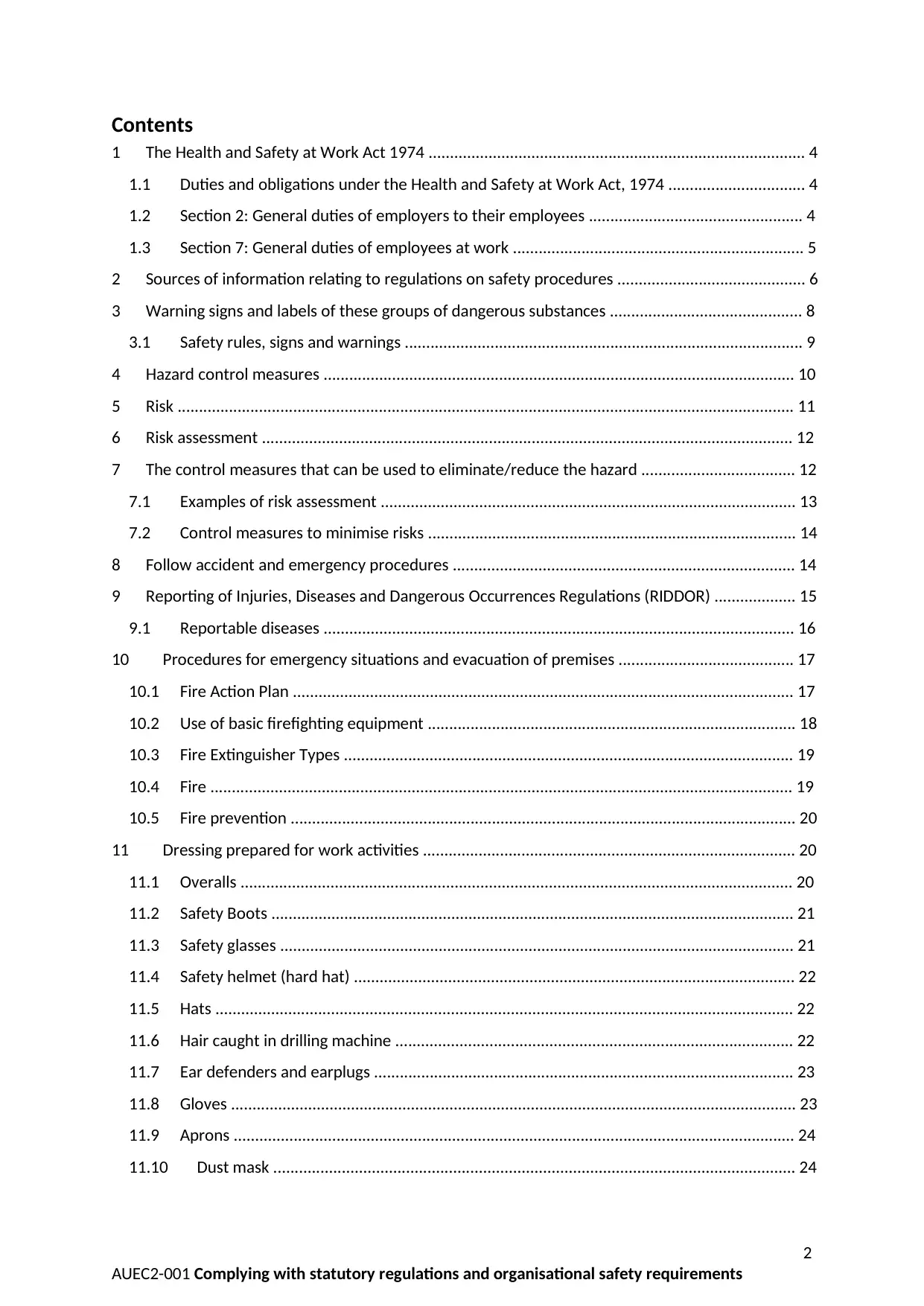
2
AUEC2-001 Complying with statutory regulations and organisational safety requirements
Contents
1 The Health and Safety at Work Act 1974 ........................................................................................ 4
1.1 Duties and obligations under the Health and Safety at Work Act, 1974 ................................ 4
1.2 Section 2: General duties of employers to their employees .................................................. 4
1.3 Section 7: General duties of employees at work .................................................................... 5
2 Sources of information relating to regulations on safety procedures ............................................ 6
3 Warning signs and labels of these groups of dangerous substances ............................................. 8
3.1 Safety rules, signs and warnings ............................................................................................. 9
4 Hazard control measures .............................................................................................................. 10
5 Risk ................................................................................................................................................ 11
6 Risk assessment ............................................................................................................................ 12
7 The control measures that can be used to eliminate/reduce the hazard .................................... 12
7.1 Examples of risk assessment ................................................................................................. 13
7.2 Control measures to minimise risks ...................................................................................... 14
8 Follow accident and emergency procedures ................................................................................ 14
9 Reporting of Injuries, Diseases and Dangerous Occurrences Regulations (RIDDOR) ................... 15
9.1 Reportable diseases .............................................................................................................. 16
10 Procedures for emergency situations and evacuation of premises ......................................... 17
10.1 Fire Action Plan ..................................................................................................................... 17
10.2 Use of basic firefighting equipment ...................................................................................... 18
10.3 Fire Extinguisher Types ......................................................................................................... 19
10.4 Fire ........................................................................................................................................ 19
10.5 Fire prevention ...................................................................................................................... 20
11 Dressing prepared for work activities ....................................................................................... 20
11.1 Overalls ................................................................................................................................. 20
11.2 Safety Boots .......................................................................................................................... 21
11.3 Safety glasses ........................................................................................................................ 21
11.4 Safety helmet (hard hat) ....................................................................................................... 22
11.5 Hats ....................................................................................................................................... 22
11.6 Hair caught in drilling machine ............................................................................................. 22
11.7 Ear defenders and earplugs .................................................................................................. 23
11.8 Gloves .................................................................................................................................... 23
11.9 Aprons ................................................................................................................................... 24
11.10 Dust mask .......................................................................................................................... 24
AUEC2-001 Complying with statutory regulations and organisational safety requirements
Contents
1 The Health and Safety at Work Act 1974 ........................................................................................ 4
1.1 Duties and obligations under the Health and Safety at Work Act, 1974 ................................ 4
1.2 Section 2: General duties of employers to their employees .................................................. 4
1.3 Section 7: General duties of employees at work .................................................................... 5
2 Sources of information relating to regulations on safety procedures ............................................ 6
3 Warning signs and labels of these groups of dangerous substances ............................................. 8
3.1 Safety rules, signs and warnings ............................................................................................. 9
4 Hazard control measures .............................................................................................................. 10
5 Risk ................................................................................................................................................ 11
6 Risk assessment ............................................................................................................................ 12
7 The control measures that can be used to eliminate/reduce the hazard .................................... 12
7.1 Examples of risk assessment ................................................................................................. 13
7.2 Control measures to minimise risks ...................................................................................... 14
8 Follow accident and emergency procedures ................................................................................ 14
9 Reporting of Injuries, Diseases and Dangerous Occurrences Regulations (RIDDOR) ................... 15
9.1 Reportable diseases .............................................................................................................. 16
10 Procedures for emergency situations and evacuation of premises ......................................... 17
10.1 Fire Action Plan ..................................................................................................................... 17
10.2 Use of basic firefighting equipment ...................................................................................... 18
10.3 Fire Extinguisher Types ......................................................................................................... 19
10.4 Fire ........................................................................................................................................ 19
10.5 Fire prevention ...................................................................................................................... 20
11 Dressing prepared for work activities ....................................................................................... 20
11.1 Overalls ................................................................................................................................. 20
11.2 Safety Boots .......................................................................................................................... 21
11.3 Safety glasses ........................................................................................................................ 21
11.4 Safety helmet (hard hat) ....................................................................................................... 22
11.5 Hats ....................................................................................................................................... 22
11.6 Hair caught in drilling machine ............................................................................................. 22
11.7 Ear defenders and earplugs .................................................................................................. 23
11.8 Gloves .................................................................................................................................... 23
11.9 Aprons ................................................................................................................................... 24
11.10 Dust mask .......................................................................................................................... 24
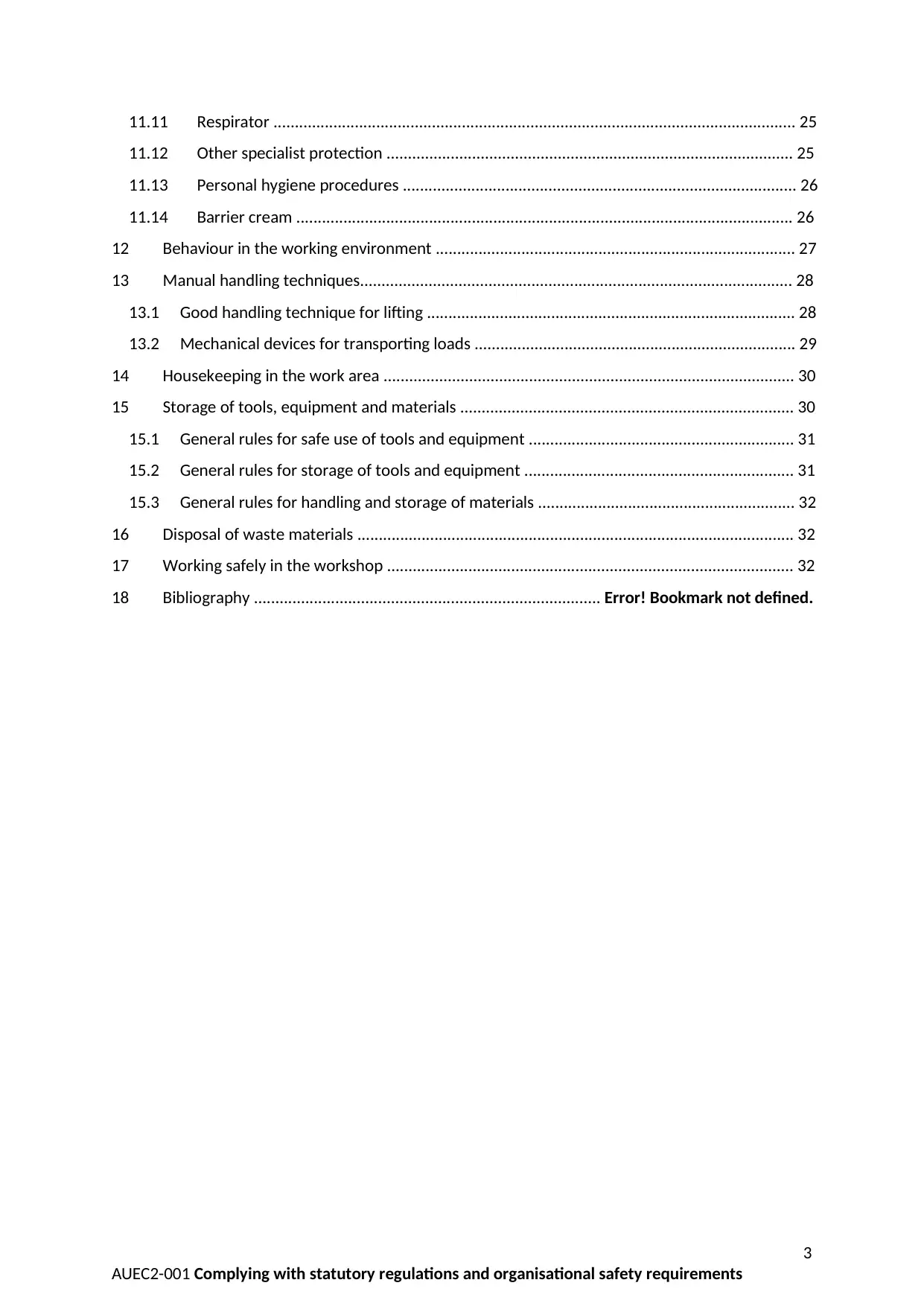
3
AUEC2-001 Complying with statutory regulations and organisational safety requirements
11.11 Respirator .......................................................................................................................... 25
11.12 Other specialist protection ............................................................................................... 25
11.13 Personal hygiene procedures ............................................................................................ 26
11.14 Barrier cream .................................................................................................................... 26
12 Behaviour in the working environment .................................................................................... 27
13 Manual handling techniques..................................................................................................... 28
13.1 Good handling technique for lifting ...................................................................................... 28
13.2 Mechanical devices for transporting loads ........................................................................... 29
14 Housekeeping in the work area ................................................................................................ 30
15 Storage of tools, equipment and materials .............................................................................. 30
15.1 General rules for safe use of tools and equipment .............................................................. 31
15.2 General rules for storage of tools and equipment ............................................................... 31
15.3 General rules for handling and storage of materials ............................................................ 32
16 Disposal of waste materials ...................................................................................................... 32
17 Working safely in the workshop ............................................................................................... 32
18 Bibliography ................................................................................. Error! Bookmark not defined.
AUEC2-001 Complying with statutory regulations and organisational safety requirements
11.11 Respirator .......................................................................................................................... 25
11.12 Other specialist protection ............................................................................................... 25
11.13 Personal hygiene procedures ............................................................................................ 26
11.14 Barrier cream .................................................................................................................... 26
12 Behaviour in the working environment .................................................................................... 27
13 Manual handling techniques..................................................................................................... 28
13.1 Good handling technique for lifting ...................................................................................... 28
13.2 Mechanical devices for transporting loads ........................................................................... 29
14 Housekeeping in the work area ................................................................................................ 30
15 Storage of tools, equipment and materials .............................................................................. 30
15.1 General rules for safe use of tools and equipment .............................................................. 31
15.2 General rules for storage of tools and equipment ............................................................... 31
15.3 General rules for handling and storage of materials ............................................................ 32
16 Disposal of waste materials ...................................................................................................... 32
17 Working safely in the workshop ............................................................................................... 32
18 Bibliography ................................................................................. Error! Bookmark not defined.
⊘ This is a preview!⊘
Do you want full access?
Subscribe today to unlock all pages.

Trusted by 1+ million students worldwide
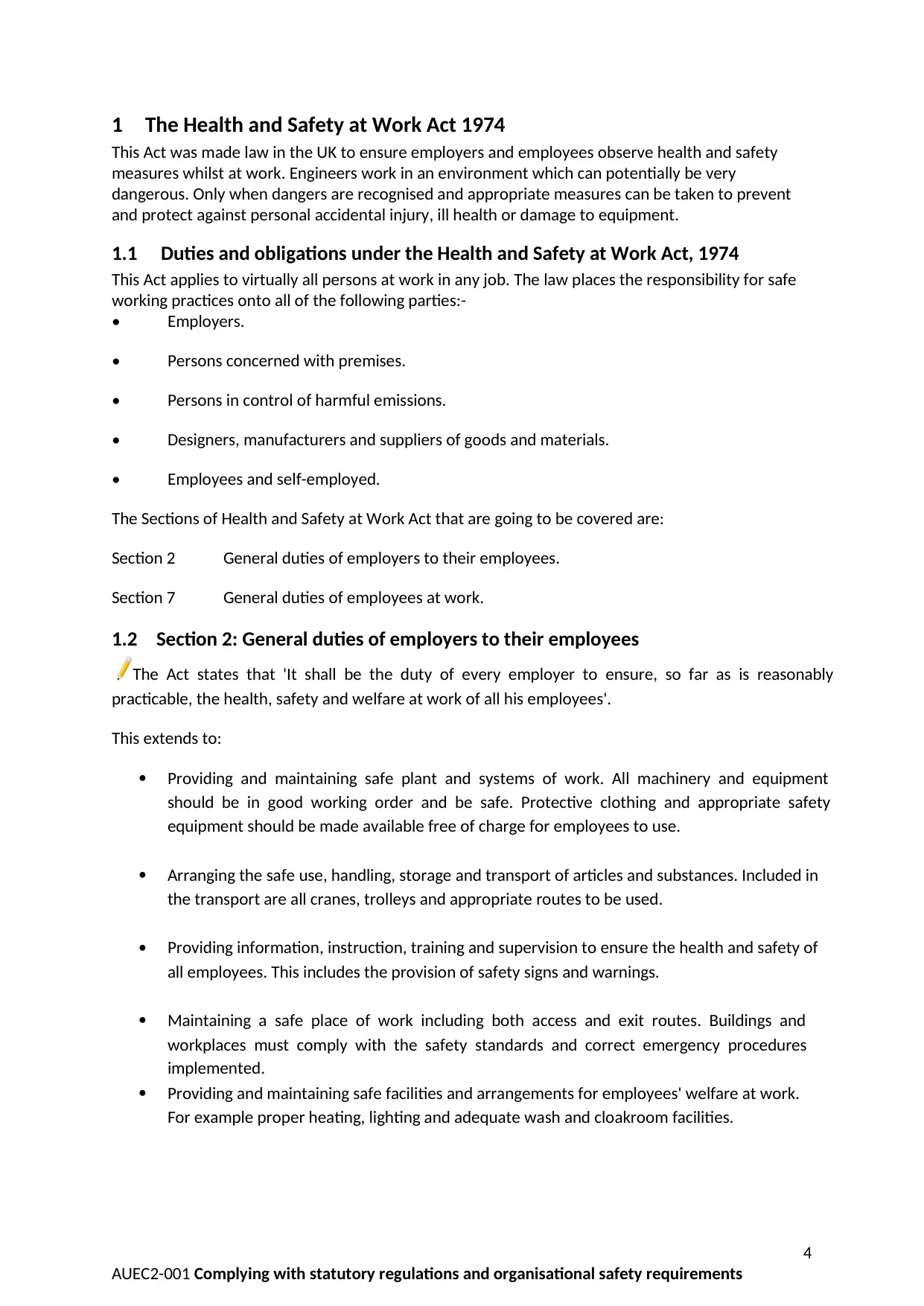
4
AUEC2-001 Complying with statutory regulations and organisational safety requirements
1 The Health and Safety at Work Act 1974
This Act was made law in the UK to ensure employers and employees observe health and safety
measures whilst at work. Engineers work in an environment which can potentially be very
dangerous. Only when dangers are recognised and appropriate measures can be taken to prevent
and protect against personal accidental injury, ill health or damage to equipment.
1.1 Duties and obligations under the Health and Safety at Work Act, 1974
This Act applies to virtually all persons at work in any job. The law places the responsibility for safe
working practices onto all of the following parties:-
• Employers.
• Persons concerned with premises.
• Persons in control of harmful emissions.
• Designers, manufacturers and suppliers of goods and materials.
• Employees and self-employed.
The Sections of Health and Safety at Work Act that are going to be covered are:
Section 2 General duties of employers to their employees.
Section 7 General duties of employees at work.
1.2 Section 2: General duties of employers to their employees
The Act states that 'It shall be the duty of every employer to ensure, so far as is reasonably
practicable, the health, safety and welfare at work of all his employees'.
This extends to:
Providing and maintaining safe plant and systems of work. All machinery and equipment
should be in good working order and be safe. Protective clothing and appropriate safety
equipment should be made available free of charge for employees to use.
Arranging the safe use, handling, storage and transport of articles and substances. Included in
the transport are all cranes, trolleys and appropriate routes to be used.
Providing information, instruction, training and supervision to ensure the health and safety of
all employees. This includes the provision of safety signs and warnings.
Maintaining a safe place of work including both access and exit routes. Buildings and
workplaces must comply with the safety standards and correct emergency procedures
implemented.
Providing and maintaining safe facilities and arrangements for employees' welfare at work.
For example proper heating, lighting and adequate wash and cloakroom facilities.
AUEC2-001 Complying with statutory regulations and organisational safety requirements
1 The Health and Safety at Work Act 1974
This Act was made law in the UK to ensure employers and employees observe health and safety
measures whilst at work. Engineers work in an environment which can potentially be very
dangerous. Only when dangers are recognised and appropriate measures can be taken to prevent
and protect against personal accidental injury, ill health or damage to equipment.
1.1 Duties and obligations under the Health and Safety at Work Act, 1974
This Act applies to virtually all persons at work in any job. The law places the responsibility for safe
working practices onto all of the following parties:-
• Employers.
• Persons concerned with premises.
• Persons in control of harmful emissions.
• Designers, manufacturers and suppliers of goods and materials.
• Employees and self-employed.
The Sections of Health and Safety at Work Act that are going to be covered are:
Section 2 General duties of employers to their employees.
Section 7 General duties of employees at work.
1.2 Section 2: General duties of employers to their employees
The Act states that 'It shall be the duty of every employer to ensure, so far as is reasonably
practicable, the health, safety and welfare at work of all his employees'.
This extends to:
Providing and maintaining safe plant and systems of work. All machinery and equipment
should be in good working order and be safe. Protective clothing and appropriate safety
equipment should be made available free of charge for employees to use.
Arranging the safe use, handling, storage and transport of articles and substances. Included in
the transport are all cranes, trolleys and appropriate routes to be used.
Providing information, instruction, training and supervision to ensure the health and safety of
all employees. This includes the provision of safety signs and warnings.
Maintaining a safe place of work including both access and exit routes. Buildings and
workplaces must comply with the safety standards and correct emergency procedures
implemented.
Providing and maintaining safe facilities and arrangements for employees' welfare at work.
For example proper heating, lighting and adequate wash and cloakroom facilities.
Paraphrase This Document
Need a fresh take? Get an instant paraphrase of this document with our AI Paraphraser
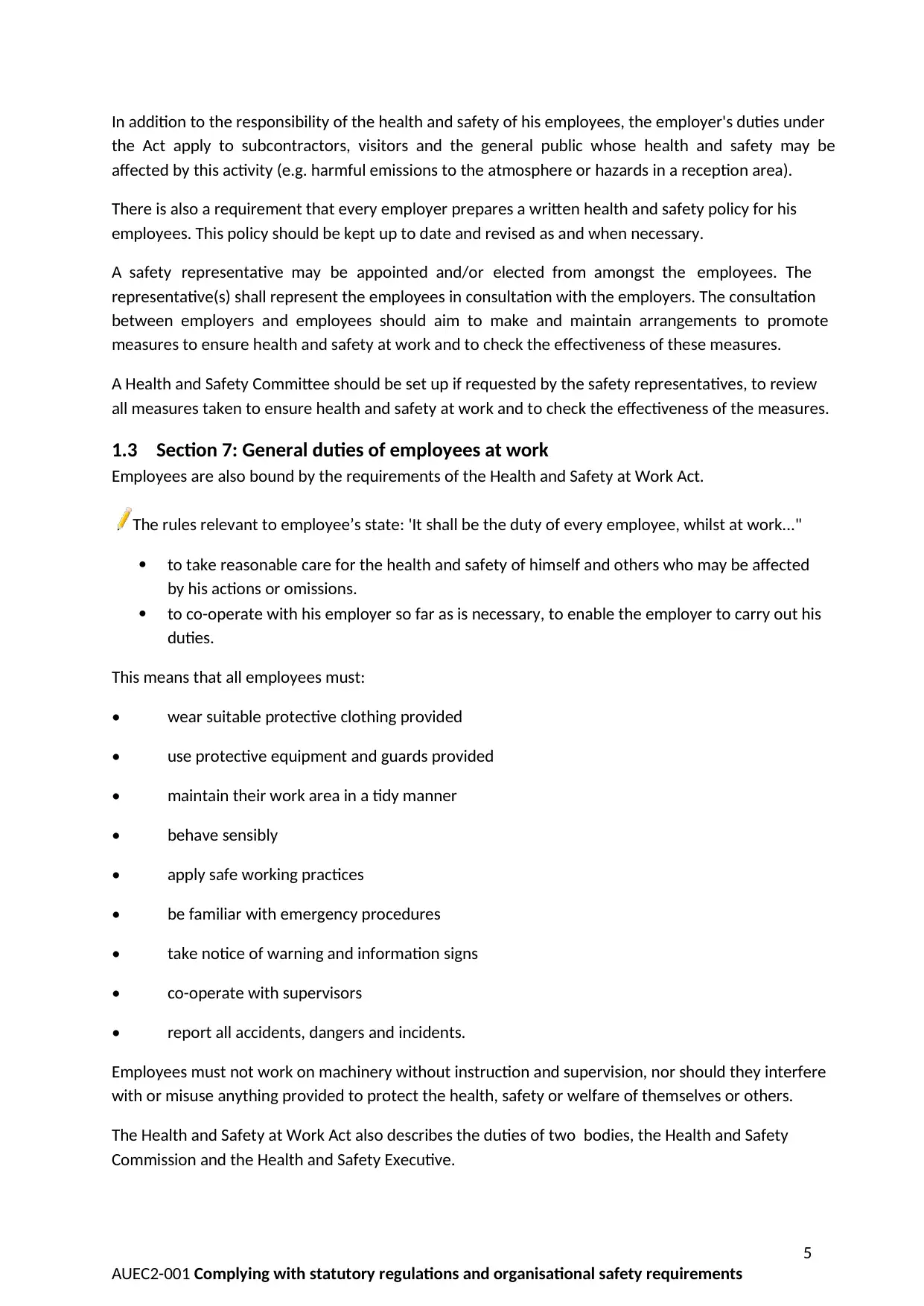
5
AUEC2-001 Complying with statutory regulations and organisational safety requirements
In addition to the responsibility of the health and safety of his employees, the employer's duties under
the Act apply to subcontractors, visitors and the general public whose health and safety may be
affected by this activity (e.g. harmful emissions to the atmosphere or hazards in a reception area).
There is also a requirement that every employer prepares a written health and safety policy for his
employees. This policy should be kept up to date and revised as and when necessary.
A safety representative may be appointed and/or elected from amongst the employees. The
representative(s) shall represent the employees in consultation with the employers. The consultation
between employers and employees should aim to make and maintain arrangements to promote
measures to ensure health and safety at work and to check the effectiveness of these measures.
A Health and Safety Committee should be set up if requested by the safety representatives, to review
all measures taken to ensure health and safety at work and to check the effectiveness of the measures.
1.3 Section 7: General duties of employees at work
Employees are also bound by the requirements of the Health and Safety at Work Act.
The rules relevant to employee’s state: 'It shall be the duty of every employee, whilst at work..."
to take reasonable care for the health and safety of himself and others who may be affected
by his actions or omissions.
to co-operate with his employer so far as is necessary, to enable the employer to carry out his
duties.
This means that all employees must:
• wear suitable protective clothing provided
• use protective equipment and guards provided
• maintain their work area in a tidy manner
• behave sensibly
• apply safe working practices
• be familiar with emergency procedures
• take notice of warning and information signs
• co-operate with supervisors
• report all accidents, dangers and incidents.
Employees must not work on machinery without instruction and supervision, nor should they interfere
with or misuse anything provided to protect the health, safety or welfare of themselves or others.
The Health and Safety at Work Act also describes the duties of two bodies, the Health and Safety
Commission and the Health and Safety Executive.
AUEC2-001 Complying with statutory regulations and organisational safety requirements
In addition to the responsibility of the health and safety of his employees, the employer's duties under
the Act apply to subcontractors, visitors and the general public whose health and safety may be
affected by this activity (e.g. harmful emissions to the atmosphere or hazards in a reception area).
There is also a requirement that every employer prepares a written health and safety policy for his
employees. This policy should be kept up to date and revised as and when necessary.
A safety representative may be appointed and/or elected from amongst the employees. The
representative(s) shall represent the employees in consultation with the employers. The consultation
between employers and employees should aim to make and maintain arrangements to promote
measures to ensure health and safety at work and to check the effectiveness of these measures.
A Health and Safety Committee should be set up if requested by the safety representatives, to review
all measures taken to ensure health and safety at work and to check the effectiveness of the measures.
1.3 Section 7: General duties of employees at work
Employees are also bound by the requirements of the Health and Safety at Work Act.
The rules relevant to employee’s state: 'It shall be the duty of every employee, whilst at work..."
to take reasonable care for the health and safety of himself and others who may be affected
by his actions or omissions.
to co-operate with his employer so far as is necessary, to enable the employer to carry out his
duties.
This means that all employees must:
• wear suitable protective clothing provided
• use protective equipment and guards provided
• maintain their work area in a tidy manner
• behave sensibly
• apply safe working practices
• be familiar with emergency procedures
• take notice of warning and information signs
• co-operate with supervisors
• report all accidents, dangers and incidents.
Employees must not work on machinery without instruction and supervision, nor should they interfere
with or misuse anything provided to protect the health, safety or welfare of themselves or others.
The Health and Safety at Work Act also describes the duties of two bodies, the Health and Safety
Commission and the Health and Safety Executive.
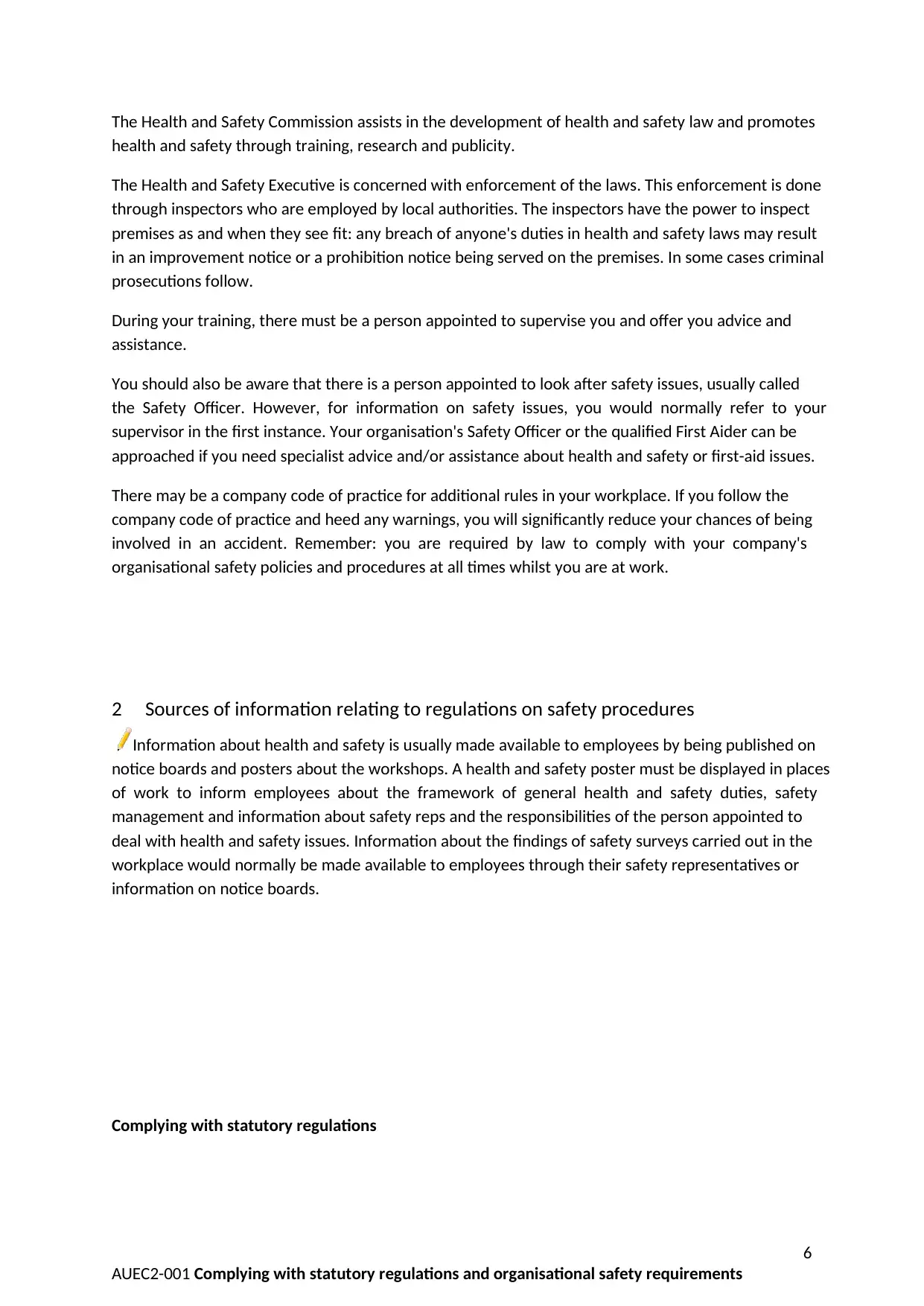
6
AUEC2-001 Complying with statutory regulations and organisational safety requirements
The Health and Safety Commission assists in the development of health and safety law and promotes
health and safety through training, research and publicity.
The Health and Safety Executive is concerned with enforcement of the laws. This enforcement is done
through inspectors who are employed by local authorities. The inspectors have the power to inspect
premises as and when they see fit: any breach of anyone's duties in health and safety laws may result
in an improvement notice or a prohibition notice being served on the premises. In some cases criminal
prosecutions follow.
During your training, there must be a person appointed to supervise you and offer you advice and
assistance.
You should also be aware that there is a person appointed to look after safety issues, usually called
the Safety Officer. However, for information on safety issues, you would normally refer to your
supervisor in the first instance. Your organisation's Safety Officer or the qualified First Aider can be
approached if you need specialist advice and/or assistance about health and safety or first-aid issues.
There may be a company code of practice for additional rules in your workplace. If you follow the
company code of practice and heed any warnings, you will significantly reduce your chances of being
involved in an accident. Remember: you are required by law to comply with your company's
organisational safety policies and procedures at all times whilst you are at work.
2 Sources of information relating to regulations on safety procedures
Information about health and safety is usually made available to employees by being published on
notice boards and posters about the workshops. A health and safety poster must be displayed in places
of work to inform employees about the framework of general health and safety duties, safety
management and information about safety reps and the responsibilities of the person appointed to
deal with health and safety issues. Information about the findings of safety surveys carried out in the
workplace would normally be made available to employees through their safety representatives or
information on notice boards.
Complying with statutory regulations
AUEC2-001 Complying with statutory regulations and organisational safety requirements
The Health and Safety Commission assists in the development of health and safety law and promotes
health and safety through training, research and publicity.
The Health and Safety Executive is concerned with enforcement of the laws. This enforcement is done
through inspectors who are employed by local authorities. The inspectors have the power to inspect
premises as and when they see fit: any breach of anyone's duties in health and safety laws may result
in an improvement notice or a prohibition notice being served on the premises. In some cases criminal
prosecutions follow.
During your training, there must be a person appointed to supervise you and offer you advice and
assistance.
You should also be aware that there is a person appointed to look after safety issues, usually called
the Safety Officer. However, for information on safety issues, you would normally refer to your
supervisor in the first instance. Your organisation's Safety Officer or the qualified First Aider can be
approached if you need specialist advice and/or assistance about health and safety or first-aid issues.
There may be a company code of practice for additional rules in your workplace. If you follow the
company code of practice and heed any warnings, you will significantly reduce your chances of being
involved in an accident. Remember: you are required by law to comply with your company's
organisational safety policies and procedures at all times whilst you are at work.
2 Sources of information relating to regulations on safety procedures
Information about health and safety is usually made available to employees by being published on
notice boards and posters about the workshops. A health and safety poster must be displayed in places
of work to inform employees about the framework of general health and safety duties, safety
management and information about safety reps and the responsibilities of the person appointed to
deal with health and safety issues. Information about the findings of safety surveys carried out in the
workplace would normally be made available to employees through their safety representatives or
information on notice boards.
Complying with statutory regulations
⊘ This is a preview!⊘
Do you want full access?
Subscribe today to unlock all pages.

Trusted by 1+ million students worldwide
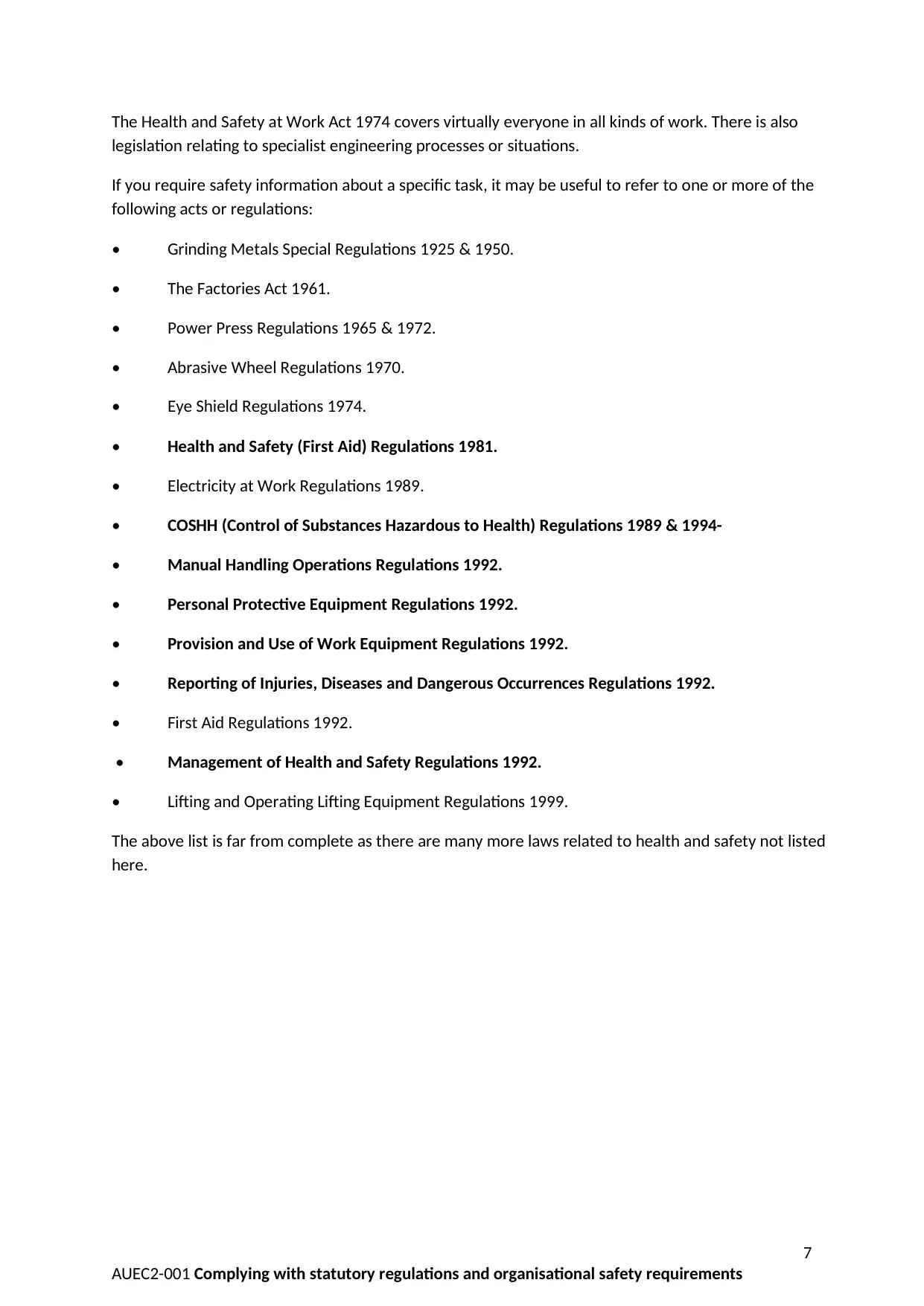
7
AUEC2-001 Complying with statutory regulations and organisational safety requirements
The Health and Safety at Work Act 1974 covers virtually everyone in all kinds of work. There is also
legislation relating to specialist engineering processes or situations.
If you require safety information about a specific task, it may be useful to refer to one or more of the
following acts or regulations:
• Grinding Metals Special Regulations 1925 & 1950.
• The Factories Act 1961.
• Power Press Regulations 1965 & 1972.
• Abrasive Wheel Regulations 1970.
• Eye Shield Regulations 1974.
• Health and Safety (First Aid) Regulations 1981.
• Electricity at Work Regulations 1989.
• COSHH (Control of Substances Hazardous to Health) Regulations 1989 & 1994-
• Manual Handling Operations Regulations 1992.
• Personal Protective Equipment Regulations 1992.
• Provision and Use of Work Equipment Regulations 1992.
• Reporting of Injuries, Diseases and Dangerous Occurrences Regulations 1992.
• First Aid Regulations 1992.
• Management of Health and Safety Regulations 1992.
• Lifting and Operating Lifting Equipment Regulations 1999.
The above list is far from complete as there are many more laws related to health and safety not listed
here.
AUEC2-001 Complying with statutory regulations and organisational safety requirements
The Health and Safety at Work Act 1974 covers virtually everyone in all kinds of work. There is also
legislation relating to specialist engineering processes or situations.
If you require safety information about a specific task, it may be useful to refer to one or more of the
following acts or regulations:
• Grinding Metals Special Regulations 1925 & 1950.
• The Factories Act 1961.
• Power Press Regulations 1965 & 1972.
• Abrasive Wheel Regulations 1970.
• Eye Shield Regulations 1974.
• Health and Safety (First Aid) Regulations 1981.
• Electricity at Work Regulations 1989.
• COSHH (Control of Substances Hazardous to Health) Regulations 1989 & 1994-
• Manual Handling Operations Regulations 1992.
• Personal Protective Equipment Regulations 1992.
• Provision and Use of Work Equipment Regulations 1992.
• Reporting of Injuries, Diseases and Dangerous Occurrences Regulations 1992.
• First Aid Regulations 1992.
• Management of Health and Safety Regulations 1992.
• Lifting and Operating Lifting Equipment Regulations 1999.
The above list is far from complete as there are many more laws related to health and safety not listed
here.
Paraphrase This Document
Need a fresh take? Get an instant paraphrase of this document with our AI Paraphraser
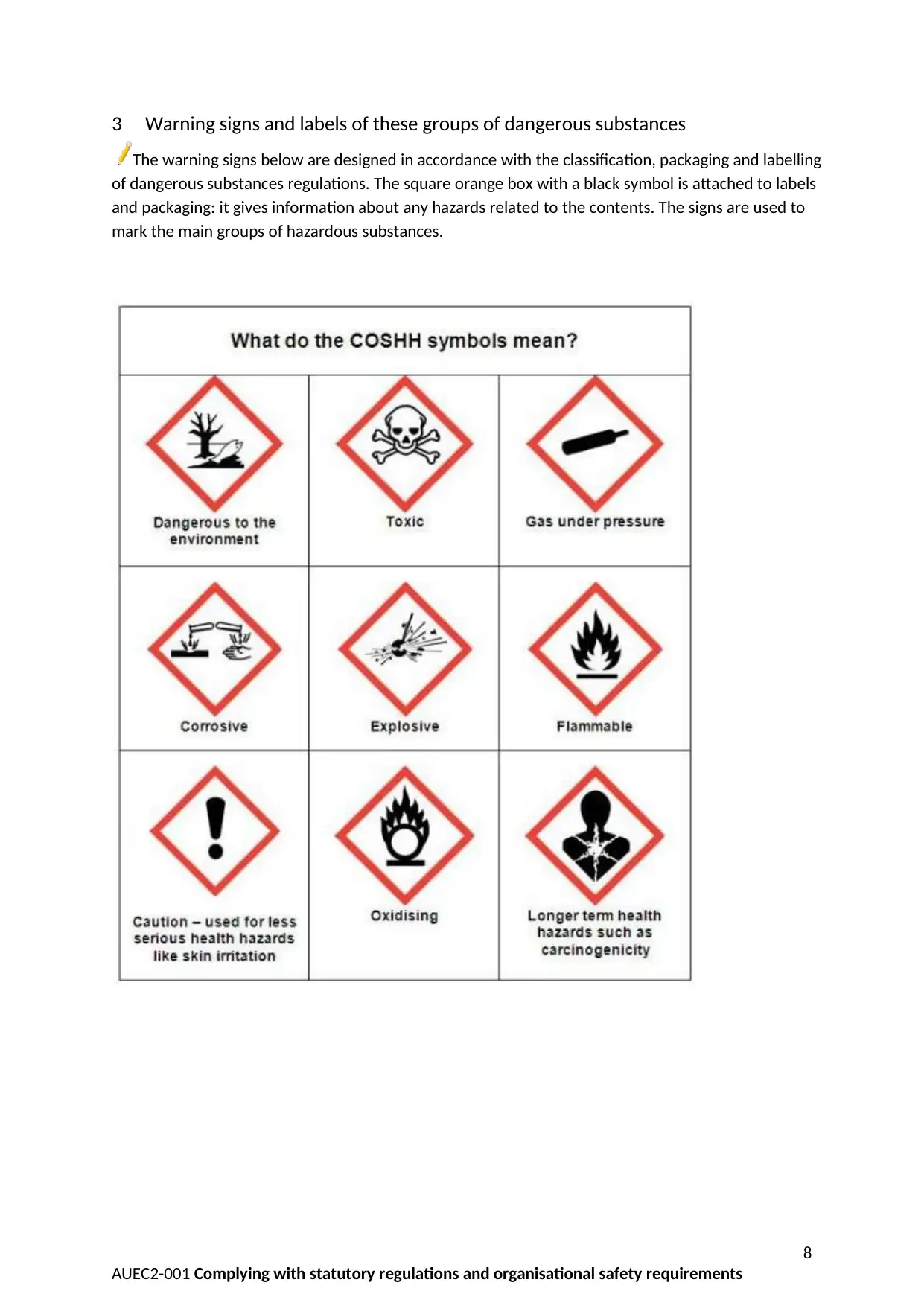
8
AUEC2-001 Complying with statutory regulations and organisational safety requirements
3 Warning signs and labels of these groups of dangerous substances
The warning signs below are designed in accordance with the classification, packaging and labelling
of dangerous substances regulations. The square orange box with a black symbol is attached to labels
and packaging: it gives information about any hazards related to the contents. The signs are used to
mark the main groups of hazardous substances.
AUEC2-001 Complying with statutory regulations and organisational safety requirements
3 Warning signs and labels of these groups of dangerous substances
The warning signs below are designed in accordance with the classification, packaging and labelling
of dangerous substances regulations. The square orange box with a black symbol is attached to labels
and packaging: it gives information about any hazards related to the contents. The signs are used to
mark the main groups of hazardous substances.
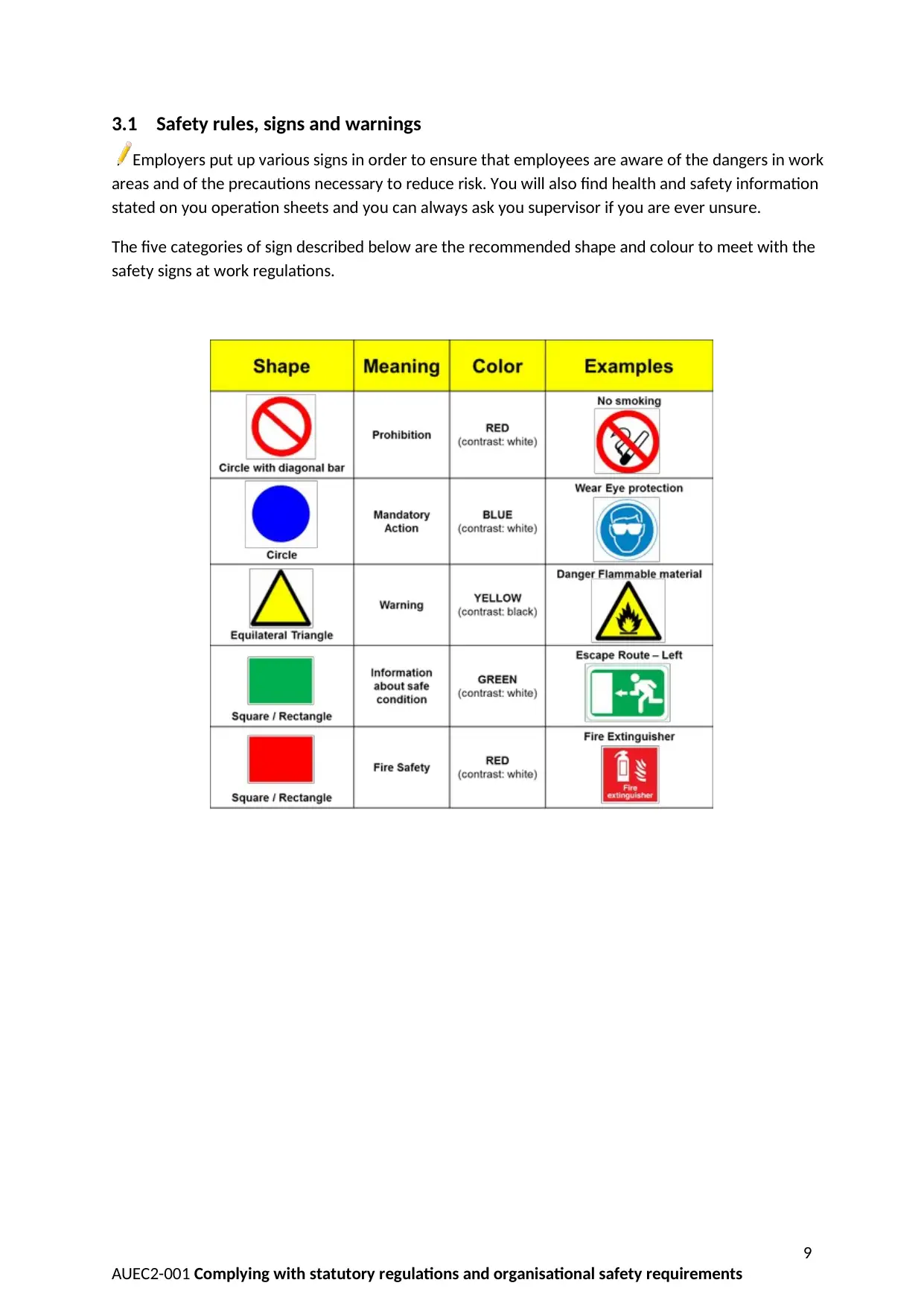
9
AUEC2-001 Complying with statutory regulations and organisational safety requirements
3.1 Safety rules, signs and warnings
Employers put up various signs in order to ensure that employees are aware of the dangers in work
areas and of the precautions necessary to reduce risk. You will also find health and safety information
stated on you operation sheets and you can always ask you supervisor if you are ever unsure.
The five categories of sign described below are the recommended shape and colour to meet with the
safety signs at work regulations.
AUEC2-001 Complying with statutory regulations and organisational safety requirements
3.1 Safety rules, signs and warnings
Employers put up various signs in order to ensure that employees are aware of the dangers in work
areas and of the precautions necessary to reduce risk. You will also find health and safety information
stated on you operation sheets and you can always ask you supervisor if you are ever unsure.
The five categories of sign described below are the recommended shape and colour to meet with the
safety signs at work regulations.
⊘ This is a preview!⊘
Do you want full access?
Subscribe today to unlock all pages.

Trusted by 1+ million students worldwide
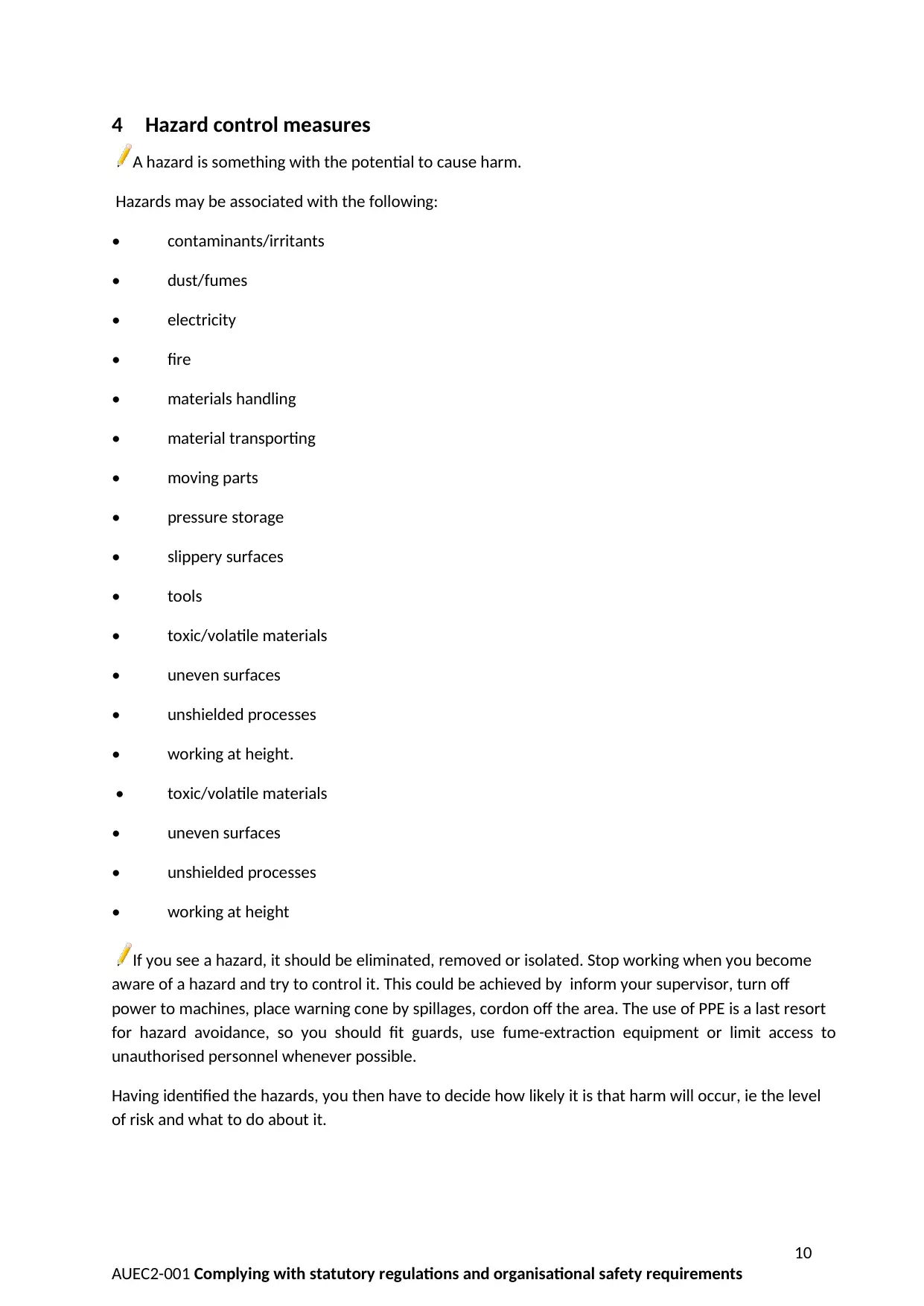
10
AUEC2-001 Complying with statutory regulations and organisational safety requirements
4 Hazard control measures
A hazard is something with the potential to cause harm.
Hazards may be associated with the following:
• contaminants/irritants
• dust/fumes
• electricity
• fire
• materials handling
• material transporting
• moving parts
• pressure storage
• slippery surfaces
• tools
• toxic/volatile materials
• uneven surfaces
• unshielded processes
• working at height.
• toxic/volatile materials
• uneven surfaces
• unshielded processes
• working at height
If you see a hazard, it should be eliminated, removed or isolated. Stop working when you become
aware of a hazard and try to control it. This could be achieved by inform your supervisor, turn off
power to machines, place warning cone by spillages, cordon off the area. The use of PPE is a last resort
for hazard avoidance, so you should fit guards, use fume-extraction equipment or limit access to
unauthorised personnel whenever possible.
Having identified the hazards, you then have to decide how likely it is that harm will occur, ie the level
of risk and what to do about it.
AUEC2-001 Complying with statutory regulations and organisational safety requirements
4 Hazard control measures
A hazard is something with the potential to cause harm.
Hazards may be associated with the following:
• contaminants/irritants
• dust/fumes
• electricity
• fire
• materials handling
• material transporting
• moving parts
• pressure storage
• slippery surfaces
• tools
• toxic/volatile materials
• uneven surfaces
• unshielded processes
• working at height.
• toxic/volatile materials
• uneven surfaces
• unshielded processes
• working at height
If you see a hazard, it should be eliminated, removed or isolated. Stop working when you become
aware of a hazard and try to control it. This could be achieved by inform your supervisor, turn off
power to machines, place warning cone by spillages, cordon off the area. The use of PPE is a last resort
for hazard avoidance, so you should fit guards, use fume-extraction equipment or limit access to
unauthorised personnel whenever possible.
Having identified the hazards, you then have to decide how likely it is that harm will occur, ie the level
of risk and what to do about it.
Paraphrase This Document
Need a fresh take? Get an instant paraphrase of this document with our AI Paraphraser
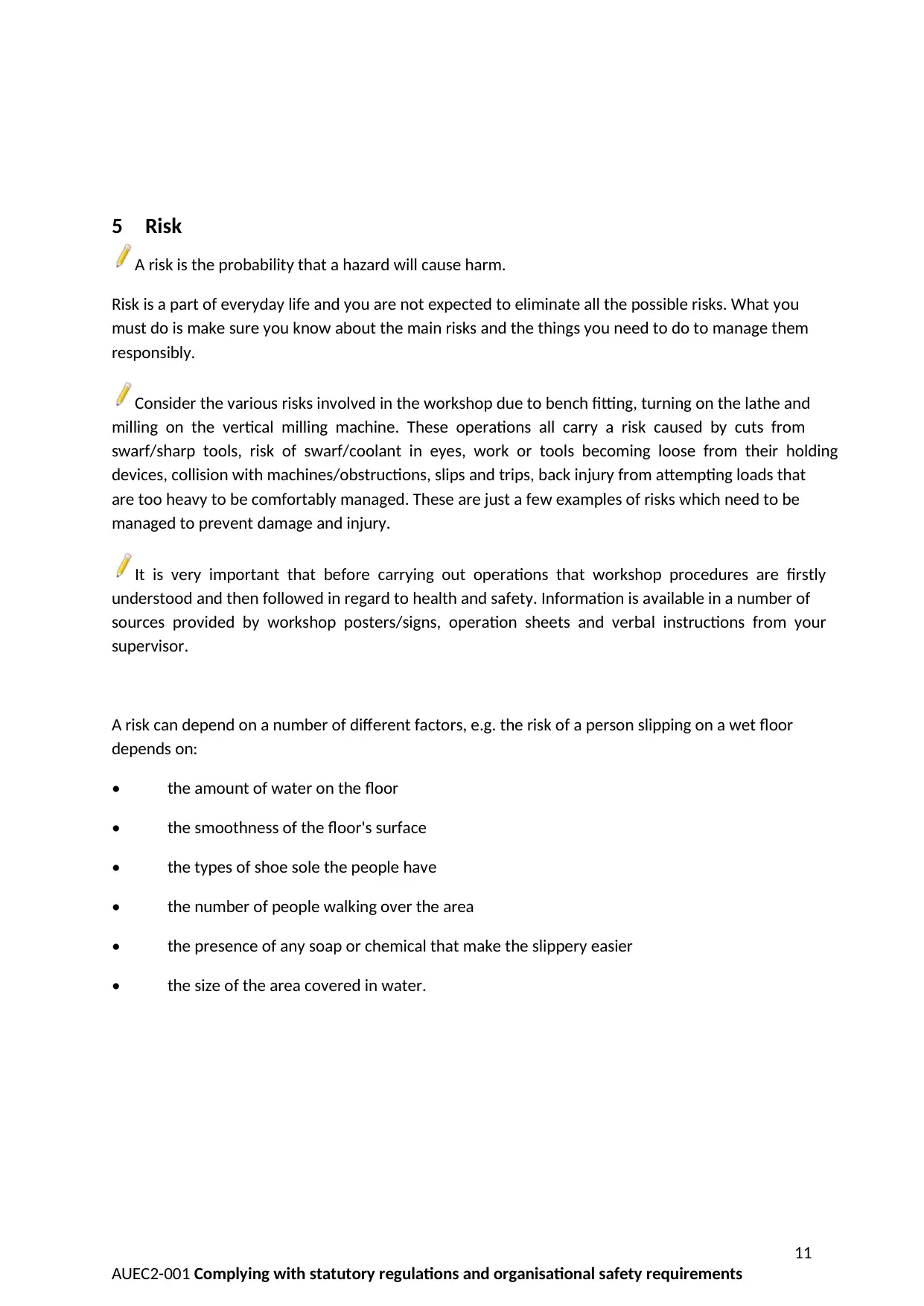
11
AUEC2-001 Complying with statutory regulations and organisational safety requirements
5 Risk
A risk is the probability that a hazard will cause harm.
Risk is a part of everyday life and you are not expected to eliminate all the possible risks. What you
must do is make sure you know about the main risks and the things you need to do to manage them
responsibly.
Consider the various risks involved in the workshop due to bench fitting, turning on the lathe and
milling on the vertical milling machine. These operations all carry a risk caused by cuts from
swarf/sharp tools, risk of swarf/coolant in eyes, work or tools becoming loose from their holding
devices, collision with machines/obstructions, slips and trips, back injury from attempting loads that
are too heavy to be comfortably managed. These are just a few examples of risks which need to be
managed to prevent damage and injury.
It is very important that before carrying out operations that workshop procedures are firstly
understood and then followed in regard to health and safety. Information is available in a number of
sources provided by workshop posters/signs, operation sheets and verbal instructions from your
supervisor.
A risk can depend on a number of different factors, e.g. the risk of a person slipping on a wet floor
depends on:
• the amount of water on the floor
• the smoothness of the floor's surface
• the types of shoe sole the people have
• the number of people walking over the area
• the presence of any soap or chemical that make the slippery easier
• the size of the area covered in water.
AUEC2-001 Complying with statutory regulations and organisational safety requirements
5 Risk
A risk is the probability that a hazard will cause harm.
Risk is a part of everyday life and you are not expected to eliminate all the possible risks. What you
must do is make sure you know about the main risks and the things you need to do to manage them
responsibly.
Consider the various risks involved in the workshop due to bench fitting, turning on the lathe and
milling on the vertical milling machine. These operations all carry a risk caused by cuts from
swarf/sharp tools, risk of swarf/coolant in eyes, work or tools becoming loose from their holding
devices, collision with machines/obstructions, slips and trips, back injury from attempting loads that
are too heavy to be comfortably managed. These are just a few examples of risks which need to be
managed to prevent damage and injury.
It is very important that before carrying out operations that workshop procedures are firstly
understood and then followed in regard to health and safety. Information is available in a number of
sources provided by workshop posters/signs, operation sheets and verbal instructions from your
supervisor.
A risk can depend on a number of different factors, e.g. the risk of a person slipping on a wet floor
depends on:
• the amount of water on the floor
• the smoothness of the floor's surface
• the types of shoe sole the people have
• the number of people walking over the area
• the presence of any soap or chemical that make the slippery easier
• the size of the area covered in water.
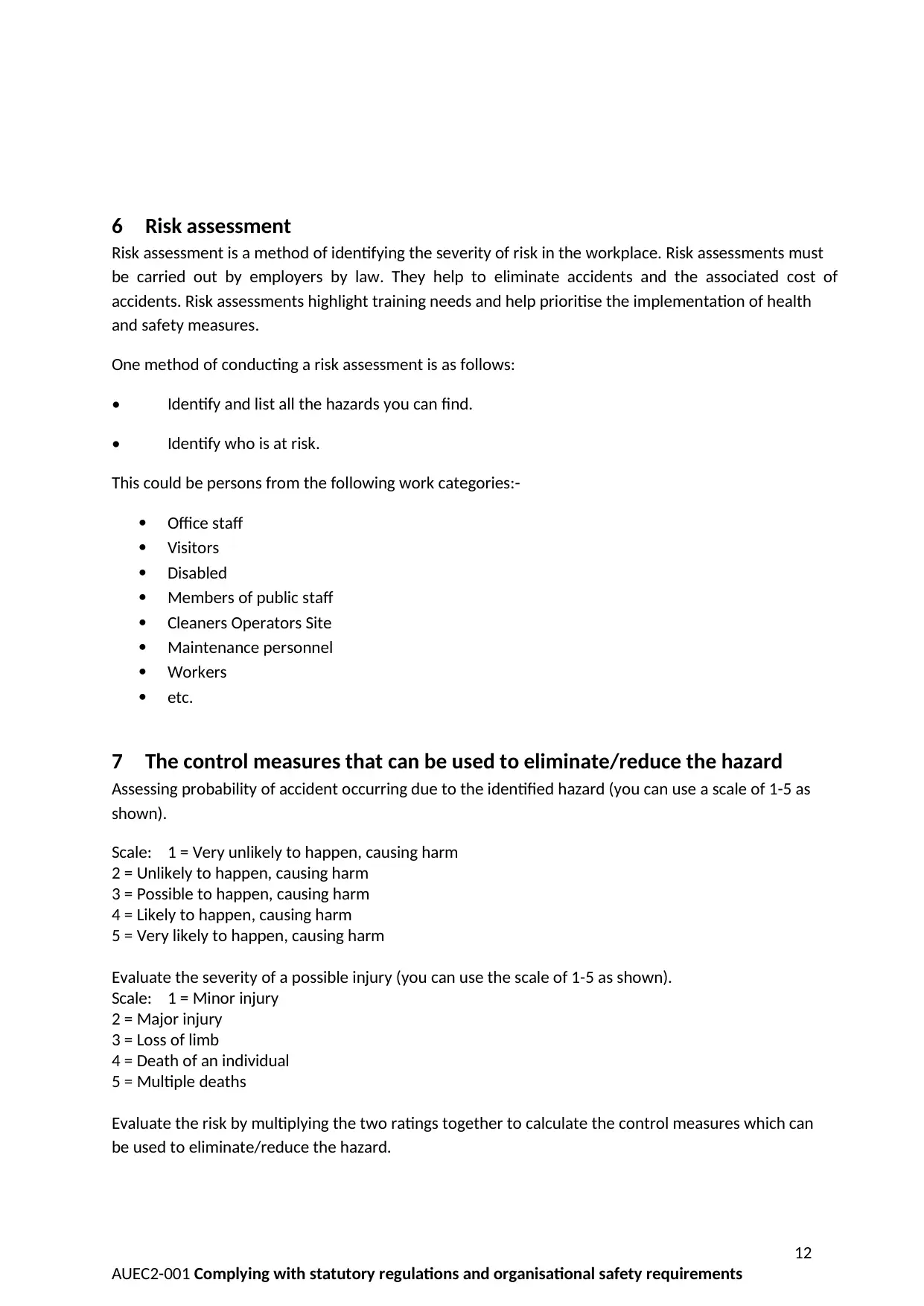
12
AUEC2-001 Complying with statutory regulations and organisational safety requirements
6 Risk assessment
Risk assessment is a method of identifying the severity of risk in the workplace. Risk assessments must
be carried out by employers by law. They help to eliminate accidents and the associated cost of
accidents. Risk assessments highlight training needs and help prioritise the implementation of health
and safety measures.
One method of conducting a risk assessment is as follows:
• Identify and list all the hazards you can find.
• Identify who is at risk.
This could be persons from the following work categories:-
Office staff
Visitors
Disabled
Members of public staff
Cleaners Operators Site
Maintenance personnel
Workers
etc.
7 The control measures that can be used to eliminate/reduce the hazard
Assessing probability of accident occurring due to the identified hazard (you can use a scale of 1-5 as
shown).
Scale: 1 = Very unlikely to happen, causing harm
2 = Unlikely to happen, causing harm
3 = Possible to happen, causing harm
4 = Likely to happen, causing harm
5 = Very likely to happen, causing harm
Evaluate the severity of a possible injury (you can use the scale of 1-5 as shown).
Scale: 1 = Minor injury
2 = Major injury
3 = Loss of limb
4 = Death of an individual
5 = Multiple deaths
Evaluate the risk by multiplying the two ratings together to calculate the control measures which can
be used to eliminate/reduce the hazard.
AUEC2-001 Complying with statutory regulations and organisational safety requirements
6 Risk assessment
Risk assessment is a method of identifying the severity of risk in the workplace. Risk assessments must
be carried out by employers by law. They help to eliminate accidents and the associated cost of
accidents. Risk assessments highlight training needs and help prioritise the implementation of health
and safety measures.
One method of conducting a risk assessment is as follows:
• Identify and list all the hazards you can find.
• Identify who is at risk.
This could be persons from the following work categories:-
Office staff
Visitors
Disabled
Members of public staff
Cleaners Operators Site
Maintenance personnel
Workers
etc.
7 The control measures that can be used to eliminate/reduce the hazard
Assessing probability of accident occurring due to the identified hazard (you can use a scale of 1-5 as
shown).
Scale: 1 = Very unlikely to happen, causing harm
2 = Unlikely to happen, causing harm
3 = Possible to happen, causing harm
4 = Likely to happen, causing harm
5 = Very likely to happen, causing harm
Evaluate the severity of a possible injury (you can use the scale of 1-5 as shown).
Scale: 1 = Minor injury
2 = Major injury
3 = Loss of limb
4 = Death of an individual
5 = Multiple deaths
Evaluate the risk by multiplying the two ratings together to calculate the control measures which can
be used to eliminate/reduce the hazard.
⊘ This is a preview!⊘
Do you want full access?
Subscribe today to unlock all pages.

Trusted by 1+ million students worldwide
1 out of 32
Related Documents
Your All-in-One AI-Powered Toolkit for Academic Success.
+13062052269
info@desklib.com
Available 24*7 on WhatsApp / Email
![[object Object]](/_next/static/media/star-bottom.7253800d.svg)
Unlock your academic potential
Copyright © 2020–2025 A2Z Services. All Rights Reserved. Developed and managed by ZUCOL.





